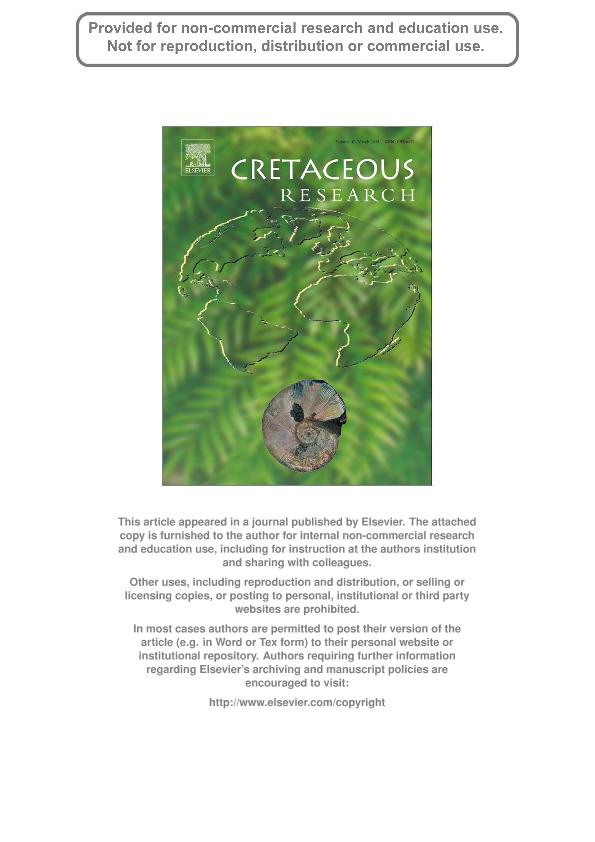Mostrar el registro sencillo del ítem
dc.contributor.author
O'gorman, Jose Patricio

dc.contributor.author
Salgado, Leonardo

dc.contributor.author
Cerda, Ignacio Alejandro

dc.contributor.author
Brandoni, Zulma Nelida

dc.date.available
2016-08-26T20:54:14Z
dc.date.issued
2013-03-31
dc.identifier.citation
O'gorman, Jose Patricio; Salgado, Leonardo; Cerda, Ignacio Alejandro; Brandoni, Zulma Nelida; First record of gastroliths associated with elasmosaur remains from La Colonia Formation (CampanianeMaastrichtian), Chubut, Patagonia Argentina, with comments on the probable depositional palaeoenvironment of the source of the gastroliths; Elsevier; Cretaceous Research; 40; 31-3-2013; 212-217
dc.identifier.issn
0195-6671
dc.identifier.uri
http://hdl.handle.net/11336/7325
dc.description.abstract
A gastrolith set, comprising 197 elements, associated with an indeterminate elasmosaurid plesiosaur collected from the CampanianeMaastrichtian La Colonia Formation, Chubut, Argentina, is described. Most of the gastroliths are discoidal (41.9%) or spheroidal (34.8%), with a mean Maximum Projection Sphericity Index value of 0.69 and a mean OP Index value of 0.74. The values of these indices are compared with those recorded for gastroliths associated with other Upper Cretaceous elasmosaurids to see if patterns with palaeobiological relevance are evident. The mean values of the Maximum Projection Sphericity Index and the Oblate-Prolate Index allow us to infer a fluvial or estuarine origin for all the elasmosaurid gastroliths for which these indices have been calculated. This inference is palaeobiologically informative because it indicates that at least some Upper Cretaceous elasmosaurs entered into estuarine (or fluvial) environments. It also helps explain the interesting vertebrate assemblage of the Allen and La Colonia formations where a rich continental fauna is recorded but elasmosaurids and polycotylids are the only well represented vertebrates with marine affinities.
dc.format
application/pdf
dc.language.iso
eng
dc.publisher
Elsevier

dc.rights
info:eu-repo/semantics/openAccess
dc.rights.uri
https://creativecommons.org/licenses/by-nc-nd/2.5/ar/
dc.subject
Elasmosauridae
dc.subject
Gastroliths
dc.subject
Upper Cretaceous
dc.subject
La Colonia Formation
dc.subject.classification
Paleontología

dc.subject.classification
Ciencias de la Tierra y relacionadas con el Medio Ambiente

dc.subject.classification
CIENCIAS NATURALES Y EXACTAS

dc.title
First record of gastroliths associated with elasmosaur remains from La Colonia Formation (CampanianeMaastrichtian), Chubut, Patagonia Argentina, with comments on the probable depositional palaeoenvironment of the source of the gastroliths
dc.type
info:eu-repo/semantics/article
dc.type
info:ar-repo/semantics/artículo
dc.type
info:eu-repo/semantics/publishedVersion
dc.date.updated
2016-07-22T18:53:18Z
dc.journal.volume
40
dc.journal.pagination
212-217
dc.journal.pais
Países Bajos

dc.journal.ciudad
Amsterdam
dc.description.fil
Fil: O'gorman, Jose Patricio. Universidad Nacional de La Plata, Museo de La Plata, División Paleontología Vertebrados; Argentina. Consejo Nacional de Investigaciones Científicas y Técnicas; Argentina
dc.description.fil
Fil: Salgado, Leonardo. Universidad Nacional de Rio Negro; Argentina. Consejo Nacional de Investigaciones Científicas y Técnicas; Argentina
dc.description.fil
Fil: Cerda, Ignacio Alejandro. Consejo Nacional de Investigaciones Científicas y Técnicas. Centro Científico Tecnológico Patagonia Norte. Instituto de Investigación en Biodiversidad y Medioambiente; Argentina
dc.description.fil
Fil: Brandoni, Zulma Nelida. Universidad Nacional de La Plata, Museo de La Plata, División Paleontología Vertebrados; Argentina. Consejo Nacional de Investigaciones Científicas y Técnicas; Argentina
dc.journal.title
Cretaceous Research

dc.relation.alternativeid
info:eu-repo/semantics/altIdentifier/doi/http://dx.doi.org/10.1016/j.cretres.2012.07.004
dc.relation.alternativeid
info:eu-repo/semantics/altIdentifier/url/http://www.sciencedirect.com/science/article/pii/S0195667112001231
Archivos asociados
